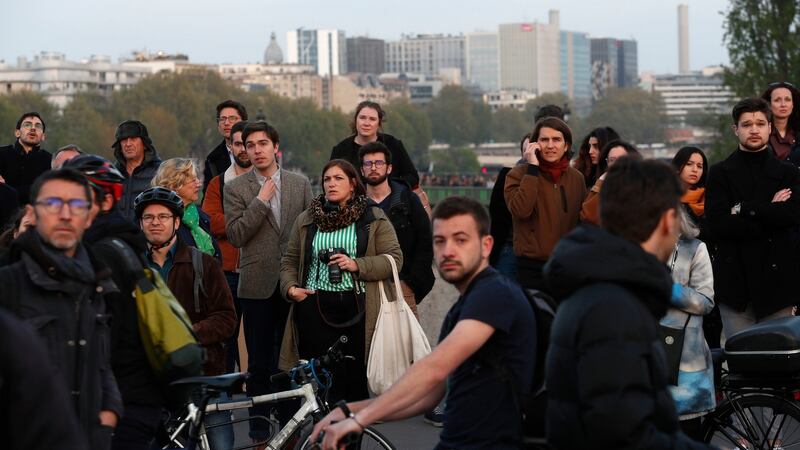Onlookers crowded behind the police line on the quai Montebello, silent and gape-mouthed, as if watching a horror film or a funeral. Some wept.
Notre Dame, world treasure, symbol of Paris and France, was burning.
The news spread just before 7pm. Everywhere the clamour of sirens, smoke, ash falling on the boulevards. No one knew on Monday night how the fire started, though there was speculation it was related to renovation work that covered much of the structure in scaffolding. A short circuit? A workman’s cigarette? No one dared suggest arson, though the Paris police opened an investigation for an unspecified crime.
Notre Dame celebrated the 850th anniversary of its foundation in 2013. Oak timbers in the roof were 1,000 years old. A rose window looked like a ball of flame. The north belfry glowed orange. A spokesman for the fire department said it was in danger of collapsing.
The spire at the centre of the Gothic cathedral burned like a torch, leaned to the right and collapsed into the sanctuary. “The spire has fallen! The spire has fallen,” a child cried from a balcony. Crashing sounds as ancient timbers fell into the nave. Soon the entire peaked roof had disappeared, leaving the cathedral a flat, burning ship, curved at the stern. Flames lapped the delicate tracery of the balustrade where the roof had begun.
Solitary fireman
Four hundred firefighters tackled the fire, but the means seemed derisory. A solitary fireman in a crane-lifted pod sprayed water at the façade, but the water fell short of its target. The cathedral is 100m high, the range of a power hose is 30m.
Notre Dame saw the trial of Joan of Arc, the crowning of Mary Stuart as Queen of France, the coronation of Napoleon. Victor Hugo made the cathedral the central character of his 1830 novel. One half expected to see his fictional hunchback, Quasimodo, scampering through the flames.
When Paris was liberated in August 1944, Gen Charles de Gaulle attended Mass there, and eluded an assassin’s bullet. The bells tolled for the victims of the 2015 and 2016 terrorist attacks.
“It breaks my heart,” said Martine, a pensioner standing beside me at the police line. “When I was a child my grandmother took me on the bâteaux mouches at night so we could see the stained glass lighted from the inside. She is our soul, even if one is not a believer.”

Copper statues
Onlookers suggested the white smoke was wood burning, while yellow smoke came from melting lead. It took 200 years to build the now collapsed spire. By chance, 16 copper statues which were part of Viollet Le Duc’s 19th century restoration were removed from the roof on April 11th, saved by the renovation.
"The cathedral is the fifth member of my family," said Marie-Jeanne, a 55-year-old consultant who has lived near the cathedral for most of her life. "As a Parisian, as a taxpayer, I am repulsed. How many fire hoses do you see? One. There is a large garden behind the cathedral where they could easily park fire engines. There are floating reservoirs in the Seine. Roissy and Orly airports have fire trucks with foam hoses. Why aren't they using tanker helicopters?"
A spokesman for the fire department said helicopters risked collapsing the vault of the cathedral.
“I went to the cathedral often. I am devastated,” said Bernard (80), a retired chemical engineer. “At my age, I will never see it rebuilt. The only thing that comforts me is that I believe the whole world will help us rebuild it.”



















